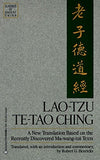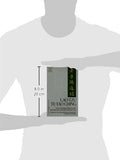Lao Tzu: Te-Tao Ching - A New Translation Based on the Recently Discovered Ma-wang-tui Texts (Classics of Ancient China)
Author: Lao Tzu
Brand: Ballantine Books
Edition: Reprint
Number Of Pages: 320
Details: Product Description Lao-tzu’s Te-Tao Ching has been treasured for thousands of years for its poetic statement of life’s most profound and elusive truths. Although the Te-Tao Ching is widely read, the author’s enigmatic style and the less than perfect condition of the Chinese originals make many of its brief poems difficult to understand. So readers of find literature hailed the discovery, in 1973, of two copies of the Te-Tao Ching which had been buried in 168 B.C. These manuscripts are more than five centuries older than any others known, and they correct many defects of later versions: their grammar and vocabulary frequently make the classic easier to understand; lost lines are restored (as many as three in some poems); some sections follow a more logical sequence. Such differences make it necessary to reevaluate traditional interpretations of the Te-Tao Ching, and Professor Henricks has done this in an extensive commentary to his excellent new translation. In addition, Professor Henricks has provided an introduction that explains the basics of Taoism and discusses the many other important finds from Ma-want-tui. From the Back Cover Lao-tzu's "Te-Tao Ching" has been treasured for thousands of years for its poetic statement of life's most profound and elusive truths. This new translation, based on the 1973 discovery of two copies of the manuscript more than five centuries older than any others known, corrects many defects of the later versions. In his extensive commentary, Professor Henricks reevaluates traditional interpretations. About the Author Robert G. Henricks is professor emeritus of religion at Dartmouth College in Hanover, New Hampshire. One of the most acclaimed authorities on classic Asian literature today, he has translated the highly regarded Lao-Tzu: Te-Tao Ching and is the author of other books, including Philosophy and Argumentation in Third-Century China and The Poetry of Han-Shan. Excerpt. © Reprinted by permission. All rights reserved. INTRODUCTION Specialists on Chinese religion and thought find it useful to distinguish, initially at least, between the Taoist religion on the one hand and philosophical Taoism on the other. We agree in dating the formal beginning of the Taoist religion to the establishment of the Celestial Master Sect, c. A.D. 150, by a man named Chang Taoling; philosophical Taoism is best represented for us in the thought of two texts written in early China, one called the Chuang-tzu, which preserves the ideas of the philosopher Chuang Chou (fl. 350-320 B.C.), the other an anonymous product known as the Lao-tzu (which means “the Old Master” or “Old Philosopher”) or the Tao-te ching (The Book of the Way and Its Power). The Lao-tzu, like the Chuang-tzu, probably represents currents of thought in China around 300 B.C., though by tradition the Lao-tzu was written by a contemporary of Confucius named Li Erh, Confucius’ dates being 551-479 B.C. There are many similar ideas in the texts of Lao-tzu and Chuang-tzu; there are major differences between the two texts as well. For example, a good part of the Lao-tzu is addressed to the man who would be king and is concerned with the correct, Taoist way to rule; Chuang-tzu has no interest in social-political matters. Chuang-tzu’s message is addressed to the rugged individualist who turns his back on social commitment in his search for the fulfilled life. There are also major differences between the two books in style. The Chuang-tzu is composed of thirty-three chapters, each chapter a mixture of philosophic discourse, anecdote, fable, and tale, stories filled with delightful, unforgettable characters. The Lao-tzu, by contrast, has a total of eighty-one chapters, each one being more like a poem in form. I. THE MA-WANG-TUI TEXTS A number of extraordinary textual discoveries have been made by archaeologists in China in the last twenty years, those discoveries providing the reason, and the materials, for the present transla
Release Date: 30-06-1992
Package Dimensions: 7.9 x 5.1 x 0.6 inches
Languages: English




